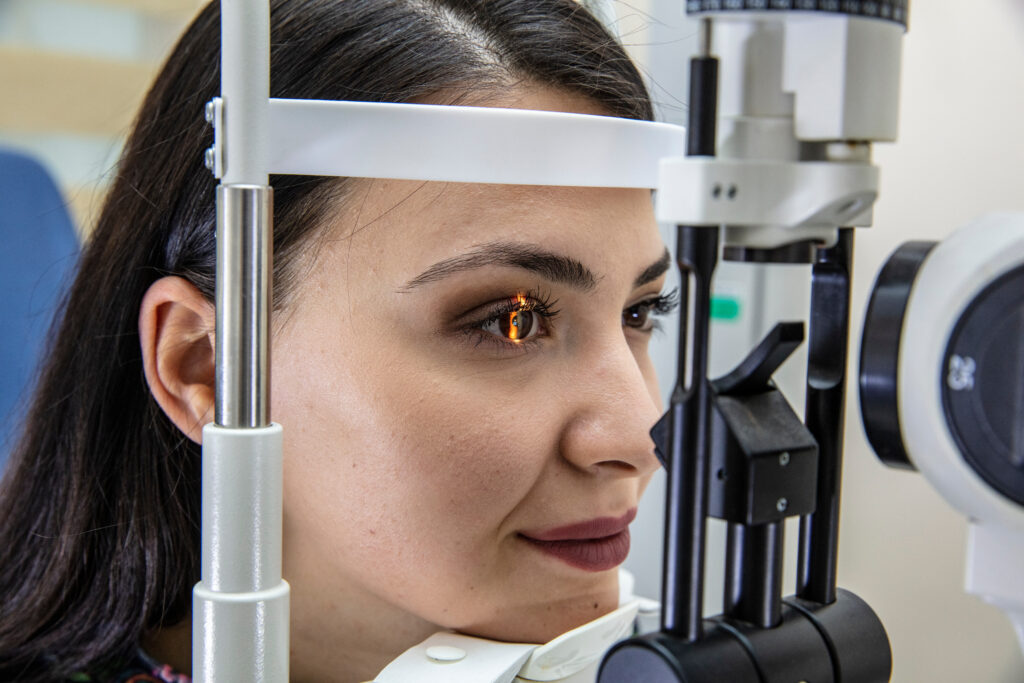
Gabriel Burton, OD
Pediatric Optometrist, Ophthalmology and Visual Sciences
- Email: burtong@nospam.wustl.edu
Refractive errors are one of the most common vision problems and can significantly impact your daily life.
The most common symptom is blurry vision, however, refractive errors can also cause double vision, hazy vision, glare, headaches, and eye strain. A refractive error occurs when the shape of your eye prevents light from focusing properly on the back of the eye where the light-sensing retina is located.
Pediatric Optometrist, Gabe Burton, gives an overview of the types of refractive errors, how they are measured, and how they can be treated.
Types of refractive errors
- Myopia (nearsightedness) is the most common refractive error, affecting 25% of adults in the US. Myopia occurs when the cornea or lens is too curved and bends light too strongly and/or if the eye is too long for the refractive power of the front of the eye. As a result, light rays focus in front of, instead of on, the retina. This causes distant objects to appear out of focus. Children may notice the board at school to be blurred and adults may notice difficulty when driving. At night, the pupil enlarges and can exacerbate the blur. Myopia often progresses throughout childhood. Some interventions appear to slow the progression. Behavioral interventions include increased time spent outdoors and reduced time spent near digital devices. Optical treatments include soft multifocal contact lenses and orthokeratology. Pharmacologic treatment of diluted atropine eye drops has shown some clinical effects on slowing myopia progression in children.
- Hyperopia(farsightedness) usually occurs when the cornea (or lens) is less curved than normal and/or the eye is too short, or a combination of these two factors. The flattened cornea can’t bend light rays enough to focus on the retina. Instead, the light rays are focused behind the retina. The vision of hyperopes is blurred both at distance and at near.
- Astigmatism occurs when the lens and/or cornea have an irregular or asymmetric shape. As a result, light rays that pass through the cornea and lens are bent unevenly and do not focus evenly on the retina. This causes vision to be blurry and distorted. Astigmatism often occurs in combination with either hyperopia or myopia.
- Presbyopia is usually first noticed by people in their early to mid-forties. Similar to hyperopia, near objects become blurred. The natural lens inside the eye that has been flexible and thus able to bend to provide good near vision starts losing its flexibility, and thus, the ability to focus on near objects, such as in reading. Reading glasses, bifocals, trifocals or progressives can help with this. In progressive lenses, the reading power gets progressively stronger as the person looks further down the lens.

Is it genetic?
Many genetic syndromes put patients at higher risk for developing refractive errors. All types of refractive errors are hereditary and contain a significant genetic component. The traits underlying refractive error such as the length of the eye and the curvature of the cornea are also heritable. Refractive errors are coded by more than one gene and the degree to which it is expressed can vary.
How are refractive errors measured?
Refractive errors cause a decrease in visual acuity; the ability to see fine detail in one’s central vision. This is measured using both subjective and objective means. Subjective methods require responses from the patient. Visual acuity is measured most commonly with a chart at a distance and/or near using letters, numbers, or pictures depending on age and ability. Not all patients can complete these tests and may require accommodations. Objective tests can be used in these cases to obtain the proper measurements. An autorefractor is a machine that gives an objective measurement of the refractive error of the eye. A handheld device called a retinoscope, along with trial lenses can also be used to determine the refractive error.
How are refractive errors treated?
Refractive errors are treated most commonly with glasses. The lenses in glasses can push the plane of focus back onto the retina in myopia, pull it forward in hyperopia or presbyopia, or combine the separate focal points into one focal point in astigmatism. Contact lenses do the same thing but are placed onto the surface of the eye to create an ocular surface curvature that will properly focus light onto the retina. Laser surgery can be performed to reshape the corneal surface. Implantable lenses may be used to correct high refractive errors in patients who cannot tolerate glasses or contact lenses. Patients who have had cataracts, or opacities in their natural lenses, may have their natural lenses removed and replaced by an artificial lens. It’s important to prioritize regular eye exams to ensure early detection and treatment of any refractive errors. Your optometrist or ophthalmologist can help determine which treatment option is best for your needs.
